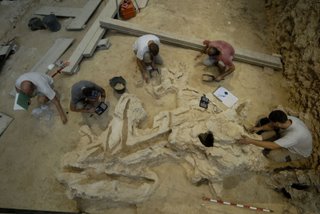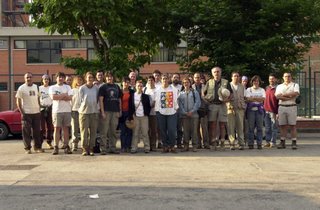
The director of the Institute of Human Paleontology (IPH) at Paris, Henry de Lumley, has declared that the Abric Romaní (Capellades, Barcelona) “is the most important site of the world to reconstruct the life of the Neanderthals”. Lumley, who has been visiting this archaeological site these days when has been discovered a tree carved by this human species 56,000 years ago, asserts that the construction of the next Museum of the Neanderthal at Capellades will be an important key to understand how was the way of life of these hominids, and will place this locality into the net of the cultural spaces of Europe about the route that these populations have traveled.
Lumley, motivated by the numerous and qualified team that works at the Abric Romaní, headed by the IPHES (Institute of Human Paleoecology and Social Evolution) and directed by Eudald Carbonell, has affirmed: “it is an exceptional site because of the special conditions which offers to the preservation of the fossils remains like the hearths and the wood tools.” This excellent preservation is determined by the abundance of calcic bicarbonate in the water of Capellades. The water that flows from the sources recovers the vegetable surface and fossilizes their external part; in this way when the woody material disappears the imprint of it remains.
The director of the IPH of Paris has noticed: “all that allows us to find out how the Neanderthals organized their camps, and reproduce, therefore, the daily scenes.” Lumley has insisted that “for the first time their system of organization can be understood.” And he has added: “there is another interesting aspect, which is that observing how they divide up the structures as the hearths, we can obtain demographical data on these populations. In the Romaní there is central fire (hearth) and many others individual, from here it could be tried to calculate how many people would occupy this space.”
Henry de Lumley has referred also to the trunk of tree located some days ago, and which has 56,000 years of antiquity: “it is an interesting discovery because for the first time we can know how was the system to carve the wood the Neanderthals used.” These groups used the wood to obtain fire, but also to make tools for the hunting, the gathering and for the domestic use.
At the same time, Lumley assures that we can conclude from the set of all these singularities of the Abric Romaní, that the Neanderthals had a complex organization, because they distributed the spaces according to its functionality: to sleep, for meeting around the fire, to cut the tools, etc.

Finally, with regard to the future construction of the Museum of the Neanderthals in Capellades, Henry de Lumley has noticed: “it will be an enclosure where no human remains will be exhibited, because in the Abric Romaní they have not been discovered yet, but will situate this archaeological site in a very important place in the network of European cultural spaces, like Tautavel (remains of 300,000 years) or Lascaux (450,000 years), both in France. Among all of them the route of the prehistoric man will be able to be followed.”
The mayor of Capellades, Angel Soteras, has assured: “the Museum of the Neanderthal will be inaugurated in the year 2009, coinciding with the first centennial of the discover of the Abric Romaní and the beginning of the first excavation.” Raül Bartroli, technician of archaeological heritage of the Town Council of Capellades has added: “the museum will be centered in showing how was the life of these populations about two central elements that give prestige and fame to the archaeological site: the hearths and the wood, as technologies that convey the social life.”
For the mayor, this museum “will revitalize a lot the village, and will have a national cultural equipment for the value of the discoveries. Every one who wants to know the Neanderthals will have to go to Capellades.” This Museum will be constructed in a new building and will be a complement of the Prehistoric Park of Capellades which includes the Abric Romaní and all the rest of archaeological sites that are part of the Capelló.

